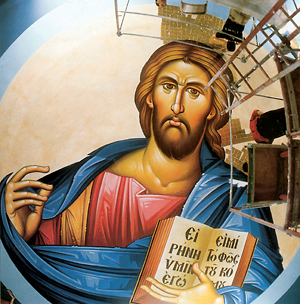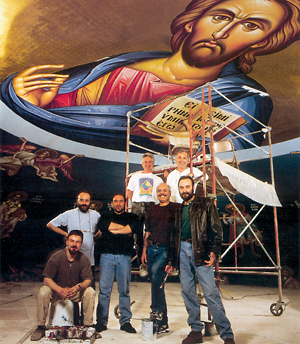Ars sacra
A SMALL ESSAY ABOUT AN ARTIST: DRAGOMIR DJEKIĆ, A SERBIAN PAINTER FROM KOSOVO, PAINTING THE LARGEST ORTHODOX TEMPLES IN NORTH AMERICA
High above Sorrow
The one who sees with his soul, sees all. Born where his homeland was born, in Kosmet, where, enticed, the homeland is lethally wounded for the nth time, the painter Djekić lies on a scaffold in the dome of the Orthodox temple in Denver. He is gazing at the calm eye of the Mother of God above him. And he knows that there, in his birth land, all that is born here, under his painting brush, is burning and vanishing. Will Our Lady of Denver really cry over Our Lady of Ljeviš, or will it be the other way round?
By: Brano Pavličić
Brezovica, then a bit further Sevac, on mountain Šar, high above sorrow that has been covering Metohija and Kosovo for years, like a thick and heavy fog. It is a place from where one can see Kopaonik a little to the right, and Prokletije a little to the left, if you turn towards the north, towards the rich world with heart of ice, cold, as its cardinal direction implies. A place from which one can clearly see the unstoppable rains of Kosovo peonies that have been falling for hundreds of years. A place from where Dragomir Djekić, painter, set off to conquer the world, carrying in his eye the mysterious color of turquoise, the wise color of the Byzantine blue, the warm color of the mountain meadows, the red color of determination, and, most painful of all, the color of gentleness and fear of his closest ones.
IN THE GOLDEN DAWN  High in the dome of the Greek Orthodox church in Denver, the largest Orthodox temple in North America, on the scaffolds, overwhelmed with heavy scents of colors and mysterious scents of incense and candles, Dragomir Djekić, gazing at the calm eye of the Mother of God in front of him, feels the breath of the silky air rising up the mountain Šar and the biting air coming down from it. High in the dome of the Greek Orthodox church in Denver, the largest Orthodox temple in North America, on the scaffolds, overwhelmed with heavy scents of colors and mysterious scents of incense and candles, Dragomir Djekić, gazing at the calm eye of the Mother of God in front of him, feels the breath of the silky air rising up the mountain Šar and the biting air coming down from it.
Painting with his calm hand the shapes and colors of frescoes and icons from the Kosmet temples he absorbed long ago, far across the world, he spreads a part of that divine richness he grew up in before the people who want to see. He patiently arranges images rising from his memory, like images being born in the moment when the air becomes completely transparent and the sky calm after rains which have been washing the horizon for days, and when, usually in the golden dawn, the palaces of the Nemanjić dynasty, between Uroševac and Lipljan, along the rippling green and blue surface of the Svrčin Lake: Pauni, Svrčin, Nerodimlje and the Petrič and Small Petrič fortresses, emerge in the distance. The bells of the Holy Archangels would start humming, immediately below the mountain where waters from mountain springs flow, the bells of that colossal temple rejected even from the most daring dreams of architects, to which it then returned. And behold, one can see the silhouette of Dečani and the Patriarchate of Peć, the one who sees with his soul, sees all, and the long ago gilded and untouched Banjska monastery glittering.
And one can see the indestructible web of interlacing paths of masons, painters… stamped by the footsteps of beauty deliverers, from place to place, from temple to temple, eternally positioned in time and inerasable like the lines of fingerprints.
And in Chicago, where he lives today, in the sea of information thrown like huge fishermen nets at the sea of people constantly moving and swaying, through the unbearable noise of the never stopping traffic, he somehow envisions the images and screams, pleas and supplications, the deposited sorrow on the oak leaf from Šara, which, gently rocking from the blue sky, flies down to his easel. And the leaf, with edges worn-out by the cruel Atlantic winds and a little faded from the strong sun, reads:
At home, nothing new has happened. Neither the last several hundreds of years, nor these days. There are only more temples for remembering and more tears, so many tears that we often don’t know whether they are tears, or is it raining for months. Only from the taste of wormwood, lilac and forget-me-not, we know it isn’t rain.
THE CRY OF A TRAVELER  From the Chicago galleries, and not only them, Djekić’ canvases pop out, people trip upon the world flowing out from them in colors with the century old patina smothering their ardor. It is something unusual which provokes wondering and doubt, causes restlessness, or something that conquers landscapes of the indirectly seen and done with its peacefulness, like perfected information from the workshop of the TV houses greatest illusionists, which they have always considered the real and only. From the Chicago galleries, and not only them, Djekić’ canvases pop out, people trip upon the world flowing out from them in colors with the century old patina smothering their ardor. It is something unusual which provokes wondering and doubt, causes restlessness, or something that conquers landscapes of the indirectly seen and done with its peacefulness, like perfected information from the workshop of the TV houses greatest illusionists, which they have always considered the real and only.
The puppets from those images, not marionettes as it is always so, but puppets missing only a personal name, reach with their live fingers the most hidden places of passersby, places in their soul where the most valuable and most intimate things and faces, events, dreams and sentiments are stored and dwell forever. They inhabit those places as truth and as the cry of a traveler before Our Lady of Ljeviš, who, many centuries ago, wrote in Arabic: ”The pupil of my eye is the nest of your beauty.”
And from beneath all these colors emerges the scent of destroyed temples, monastic cells set on fire, plundered treasuries, scattered through time in London, Berlin, Sofia, Vienna and Istanbul museums, the heavy scent of soot, blood and crimes, and the cry of the poet before the fresco: ”Who has dug your eyes out, oh, beautiful painting…”
And from beneath all these colors comes the sound of Rodop’s bells, hidden under the ground for several centuries, since their home, the Church of St. Nicholas by Peć, was burnt and destroyed. The ones who knew them were always able to hear them, wherever they were.
From beneath these colors emerges the beautiful white church of Samodreža, where emperor Lazar’s warriors took communion in the eve of the Battle of Kosovo, and emerge the fire site of the monastery with a beautiful name of Devič and the desecrated tomb of St. Joanikije.
Is there any other place on this earth where a human can hide, except in the beauty he created, in the highest dome, surrounded with gentleness and images flying from all sides, especially from the human soul, so many times humiliated, in representations of goodness and pride, which are attacked from all sides?
The one who sees with his eyes, sees the most terrible sorrow overflowing in waves, leaving behind petrified people, chained by pure evil, hypocrisy and lies, sees the tear from the Virgin’s eye, and feels it flowing down his own cheeks in strings of pearls.
***
Biography
Dragomir Djekić was born in 1964. in Sevac, Brezovica, on mountain Šar. He graduated from the Middle Artistic School in Niš, and from the Academy of Fine Arts in Belgrade in 1989, in the class of professor Milica Stevanović.
After a dozen one-man and the same number of group exhibitions, he went to the United States, where he mostly exhibited his works in Chicago, and where he is engaged in fresco-painting and iconography, restoring, enriching and painting the old and new Orthodox temples.
In Belgrade, he was awarded for the best mosaic from the Fund of the Academy of Fine Arts in 1988; he won first prize for painting from the Petar Lubarda Fund in 1989, and an award for the drawing of an animal from the Petar and Vera Lubarda Fund in 1988. |
